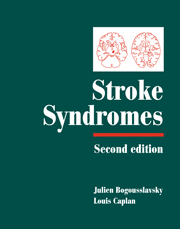Book contents
- Frontmatter
- Contents
- List of contributors
- Preface
- PART I CLINICAL MANIFESTATIONS
- PART II VASCULAR TOPOGRAPHIC SYNDROMES
- 29 Arterial territories of human brain
- 30 Superficial middle cerebral artery syndromes
- 31 Lenticulostriate arteries
- 32 Anterior cerebral artery
- 33 Anterior choroidal artery territory infarcts
- 34 Thalamic infarcts and hemorrhages
- 35 Caudate infarcts and hemorrhages
- 36 Posterior cerebral artery
- 37 Large and panhemispheric infarcts
- 38 Multiple, multilevel and bihemispheric infarcts
- 39 Midbrain infarcts
- 40 Pontine infarcts and hemorrhages
- 41 Medullary infarcts and hemorrhages
- 42 Cerebellar stroke syndromes
- 43 Extended infarcts in the posterior circulation (brainstem/cerebellum)
- 44 Border zone infarcts
- 45 Classical lacunar syndromes
- 46 Putaminal hemorrhages
- 47 Lobar hemorrhages
- 48 Intraventricular hemorrhages
- 49 Subarachnoid hemorrhage syndromes
- 50 Brain venous thrombosis syndromes
- 51 Carotid occlusion syndromes
- 52 Cervical artery dissection syndromes
- 53 Syndromes related to large artery thromboembolism within the vertebrobasilar system
- 54 Spinal stroke syndromes
- Index
- Plate section
37 - Large and panhemispheric infarcts
from PART II - VASCULAR TOPOGRAPHIC SYNDROMES
Published online by Cambridge University Press: 17 May 2010
- Frontmatter
- Contents
- List of contributors
- Preface
- PART I CLINICAL MANIFESTATIONS
- PART II VASCULAR TOPOGRAPHIC SYNDROMES
- 29 Arterial territories of human brain
- 30 Superficial middle cerebral artery syndromes
- 31 Lenticulostriate arteries
- 32 Anterior cerebral artery
- 33 Anterior choroidal artery territory infarcts
- 34 Thalamic infarcts and hemorrhages
- 35 Caudate infarcts and hemorrhages
- 36 Posterior cerebral artery
- 37 Large and panhemispheric infarcts
- 38 Multiple, multilevel and bihemispheric infarcts
- 39 Midbrain infarcts
- 40 Pontine infarcts and hemorrhages
- 41 Medullary infarcts and hemorrhages
- 42 Cerebellar stroke syndromes
- 43 Extended infarcts in the posterior circulation (brainstem/cerebellum)
- 44 Border zone infarcts
- 45 Classical lacunar syndromes
- 46 Putaminal hemorrhages
- 47 Lobar hemorrhages
- 48 Intraventricular hemorrhages
- 49 Subarachnoid hemorrhage syndromes
- 50 Brain venous thrombosis syndromes
- 51 Carotid occlusion syndromes
- 52 Cervical artery dissection syndromes
- 53 Syndromes related to large artery thromboembolism within the vertebrobasilar system
- 54 Spinal stroke syndromes
- Index
- Plate section
Summary
Introduction
Within the first few days after hemispheric stroke, mortality is mainly determined by the extent and location of space-occupying postischemic brain edema which leads to intracranial hypertension, brain tissue shifts, and tentorial herniation (Hacke et al., 1996). Medical complications and co-morbidity are the predominant causes of death in those patients who survive this critical time period of approximately 1 week.
Until a few years ago, large hemispheric strokes were commonly accepted as an untreatable disease with a uniformly poor prognosis. However, recent developments in diagnosis and pathophysiology have led to new monitoring and treatment strategies which may improve mortality and lead to a better functional outcome of the surviving patients.
In this chapter we will review the basic diagnostic and therapeutic approach to patients with large life-threatening hemispheric infarcts. We define hemispheric infarcts as ‘large’ when more than 50% of the MCA territory is affected and as ‘panhemispheric’ when the ACA or PCA territory is infarcted in addition to a large MCA territory stroke. Brainstem and cerebellar infarcts will not be discussed here.
Epidemiology and etiology
Because the infarct size was not considered in most epidemiological stroke studies, the incidence of large hemispheric infarcts according to our definition is not known exactly. As a rough estimate, 5–10% of all ischemic strokes are taken to meet the above-mentioned criteria of large or panhemispheric strokes (Hacke et al., 1996; Krieger et al., 1999; Wijdiks & Diringer, 1998).
The vast majority of large infarcts are embolic in origin. The main source of embolism is the heart, with atrial fibrillation as the most common cause, followed by artery-to-artery embolism after dissection of the internal carotid artery.
- Type
- Chapter
- Information
- Stroke Syndromes , pp. 490 - 498Publisher: Cambridge University PressPrint publication year: 2001
- 1
- Cited by



